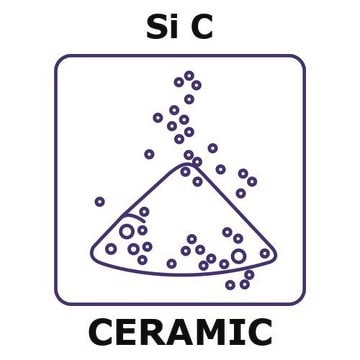594911
Silicon carbide
nanopowder, <100 nm particle size
Sinonimo/i:
Carbon silicide, Carborundum, Methanidylidynesilanylium, Silicon monocarbide
About This Item
Prodotti consigliati
Forma fisica
nanopowder
Area superficiale
70-90 m2/g
Dimensione particelle
<100 nm
Punto di fusione
2700 °C (lit.)
Densità
3.22 g/mL at 25 °C (lit.)
Densità bulk
0.069 g/cm3
Stringa SMILE
[C-]#[Si+]
InChI
1S/CSi/c1-2
HBMJWWWQQXIZIP-UHFFFAOYSA-N
Cerchi prodotti simili? Visita Guida al confronto tra prodotti
Categorie correlate
Descrizione generale
Applicazioni
- Overview of silicon carbide power devices: This document provides a comprehensive review of the characteristics and applications of silicon carbide (SiC) in power devices, discussing its advantages over traditional silicon devices in handling high voltages and efficiencies (Choi, 2016).
Stato fisico
Codice della classe di stoccaggio
11 - Combustible Solids
Classe di pericolosità dell'acqua (WGK)
nwg
Punto d’infiammabilità (°F)
Not applicable
Punto d’infiammabilità (°C)
Not applicable
Dispositivi di protezione individuale
dust mask type N95 (US), Eyeshields, Gloves
Certificati d'analisi (COA)
Cerca il Certificati d'analisi (COA) digitando il numero di lotto/batch corrispondente. I numeri di lotto o di batch sono stampati sull'etichetta dei prodotti dopo la parola ‘Lotto’ o ‘Batch’.
Possiedi già questo prodotto?
I documenti relativi ai prodotti acquistati recentemente sono disponibili nell’Archivio dei documenti.
I clienti hanno visto anche
Articoli
Composite materials with micron scale reinforcements offer tailored properties for various applications.
Silica's versatility spans various industries, including biomedical applications.
Three approaches generate white light, including LED-based down-conversion for broader applications.
Il team dei nostri ricercatori vanta grande esperienza in tutte le aree della ricerca quali Life Science, scienza dei materiali, sintesi chimica, cromatografia, discipline analitiche, ecc..
Contatta l'Assistenza Tecnica.



